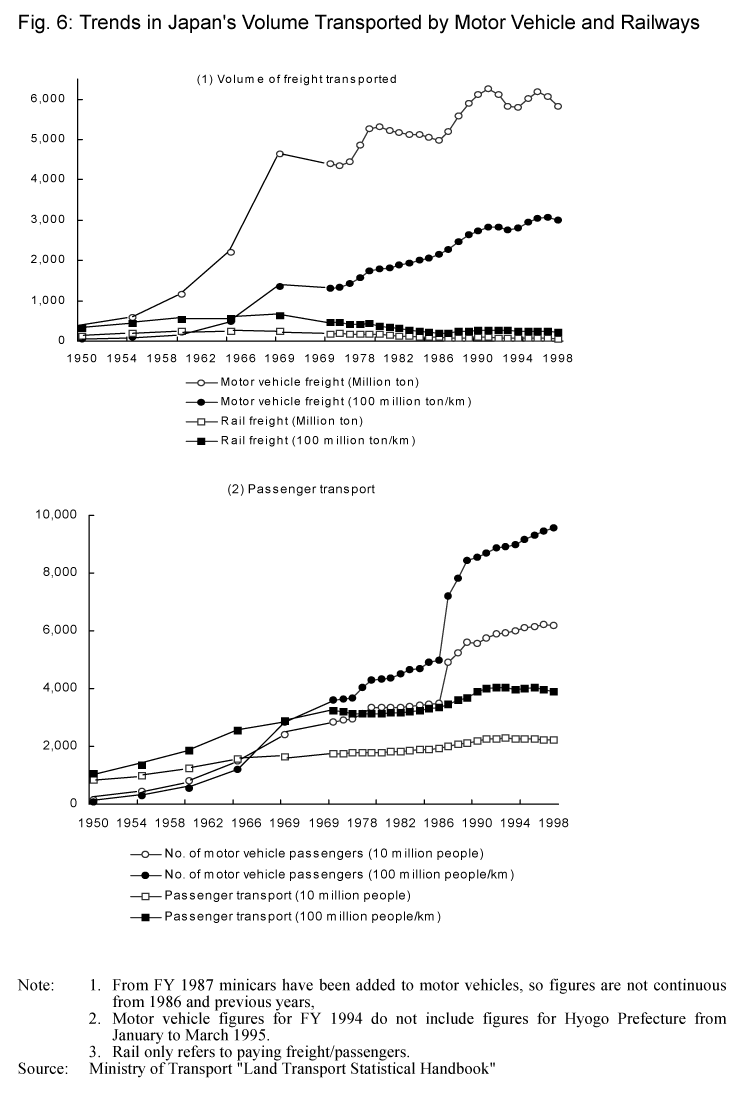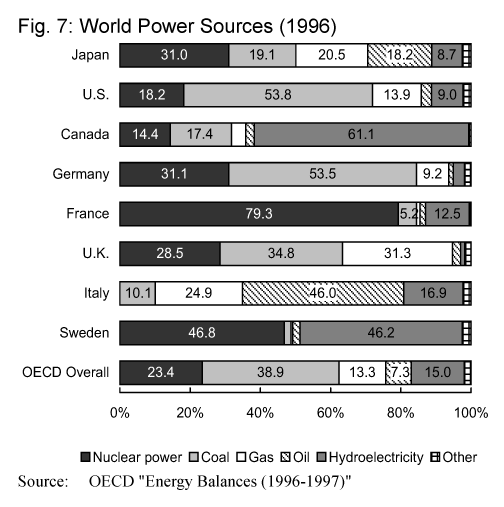| Home > Policy > White Paper, Notice, Announcement > White Paper > Annual Report on the Promotion of Science and Technology 2000 > Part1 Chapter2 Section1 2 | ||
![]() The motor vehicle, a symbol of modern civilization, has dramatically
developed as a transportational mean on whole surfaces from rail transport on
fixed lines. It is outstanding in volume transported compared to other means
of transport such as railways and aircraft ( Fig.
6 ).
The motor vehicle, a symbol of modern civilization, has dramatically
developed as a transportational mean on whole surfaces from rail transport on
fixed lines. It is outstanding in volume transported compared to other means
of transport such as railways and aircraft ( Fig.
6 ).

![]() The history of aircraft started with man's first powered flight
in 1903, and aircraft have developed dramatically through the 20th century as
a high-speed, long-distance means of transport.
The history of aircraft started with man's first powered flight
in 1903, and aircraft have developed dramatically through the 20th century as
a high-speed, long-distance means of transport.
![]() However, these means of transport use vast amounts of fossil
fuel energy, and there is increasing concern about the depletion of resources,
and environmental problems caused by the carbon dioxide and harmful gases contained
in exhaust gas.
However, these means of transport use vast amounts of fossil
fuel energy, and there is increasing concern about the depletion of resources,
and environmental problems caused by the carbon dioxide and harmful gases contained
in exhaust gas.
![]() Making the first successful experiment to launch a liquid
fueled rocket in 1926, mankind succeed the first earth satellite in history in
1957. After that, in 1961 the first manned space flight occurred and in 1969
mankind, at last, landed on the moon. It was one giant leap for mankind.
Making the first successful experiment to launch a liquid
fueled rocket in 1926, mankind succeed the first earth satellite in history in
1957. After that, in 1961 the first manned space flight occurred and in 1969
mankind, at last, landed on the moon. It was one giant leap for mankind.
![]() In the following years, the reusable Space Shuttle carried
out approximately 100 flights until now, creating much success such as gathering
data and making experiments concerning the earth and the universe.
In the following years, the reusable Space Shuttle carried
out approximately 100 flights until now, creating much success such as gathering
data and making experiments concerning the earth and the universe.
![]() In 1913 America's Henry Ford introduced a conveyor system
for the production of motor vehicles. Thanks to this introduction, the number
of vehicles produced in 1914 at Ford Company was more than the sum of other 299
motor vehicle manufacturers.
In 1913 America's Henry Ford introduced a conveyor system
for the production of motor vehicles. Thanks to this introduction, the number
of vehicles produced in 1914 at Ford Company was more than the sum of other 299
motor vehicle manufacturers.
![]() Furthermore, after World War II, automatic control technology
and intelligentization were achieved, creating new production technology called "mechatronics."
Furthermore, after World War II, automatic control technology
and intelligentization were achieved, creating new production technology called "mechatronics."
![]() The advancement in mass production technology resulted in "a
Mass Production - Mass Consumption - Mass Disposal Society." Home electrical
appliances became widespread, but ecosystems and the environment were destroyed
and non-renewable resources are consumed in massive quantities.
The advancement in mass production technology resulted in "a
Mass Production - Mass Consumption - Mass Disposal Society." Home electrical
appliances became widespread, but ecosystems and the environment were destroyed
and non-renewable resources are consumed in massive quantities.
![]() The development of synthetic chemistry, typified by the manufacture
of aniline and other synthetic dyes in the second half of the 19th century, was
quite marked, and gave us the subsequent era of synthetic pharmaceuticals.
The development of synthetic chemistry, typified by the manufacture
of aniline and other synthetic dyes in the second half of the 19th century, was
quite marked, and gave us the subsequent era of synthetic pharmaceuticals.
![]() In addition to the development of nylon and the synthesis
of ammonia which has enabled the mass production of chemical fertilizer, recent
years have appeared "new materials" which are being used in wide-ranging
applications.
In addition to the development of nylon and the synthesis
of ammonia which has enabled the mass production of chemical fertilizer, recent
years have appeared "new materials" which are being used in wide-ranging
applications.
![]() Meanwhile, in synthetic chemistry and other chemical industries,
a variety of chemical agents are used and in some cases heavy metals are also
used, moreover large quantities of industrial waste are generated. These facts
often lead pollution problems.
Meanwhile, in synthetic chemistry and other chemical industries,
a variety of chemical agents are used and in some cases heavy metals are also
used, moreover large quantities of industrial waste are generated. These facts
often lead pollution problems.
![]() With regard to atomic energy, nuclear power generation was
carried out for the first time in the world in 1951 with the fast reactor (EBR-1)
in the US. In Japan, an atomic energy budget was included for the first time
as basic research expenses and survey expenses to build a nuclear reactor in
1954, and commercial nuclear power generation started in 1966.
With regard to atomic energy, nuclear power generation was
carried out for the first time in the world in 1951 with the fast reactor (EBR-1)
in the US. In Japan, an atomic energy budget was included for the first time
as basic research expenses and survey expenses to build a nuclear reactor in
1954, and commercial nuclear power generation started in 1966.
![]() Currently a large quantity of the world power needs are supplied
by nuclear power generation, and it has become a vital supply source for power
( Fig. 7 ).
Currently a large quantity of the world power needs are supplied
by nuclear power generation, and it has become a vital supply source for power
( Fig. 7 ).

![]() Recently interests about natural energies and other new forms
of energy are increasing, but it is impossible for these natural energies alone
to answer for the future demand for power. Steady research and development into
fast breeder reactors and nuclear fusion are required.
Recently interests about natural energies and other new forms
of energy are increasing, but it is impossible for these natural energies alone
to answer for the future demand for power. Steady research and development into
fast breeder reactors and nuclear fusion are required.
![]() With the transistor invented in 1948, electronics came to
infiltrate a large number of industrial fields.
With the transistor invented in 1948, electronics came to
infiltrate a large number of industrial fields.
![]() Integrated circuits (ICs) were invented in 1959, after that
large-scale integrated circuits (LSIs) and ultra LSIs were developed to the point
where we have reached the era of ultra-ultra LSI in which the degree of location
is several million gates. The degree of location of semiconductors quadruples
in three years.
Integrated circuits (ICs) were invented in 1959, after that
large-scale integrated circuits (LSIs) and ultra LSIs were developed to the point
where we have reached the era of ultra-ultra LSI in which the degree of location
is several million gates. The degree of location of semiconductors quadruples
in three years.
![]() Semiconductors are the cornerstone that support electronic
devices and computer technology, the characteristic of modern society. They are
strongly related to a variety of situations in the workplace and home life of
modern people who lives in "electronic society," and they are one of
this century's most important inventions which play a vital role in supporting
and developing these technologies.
Semiconductors are the cornerstone that support electronic
devices and computer technology, the characteristic of modern society. They are
strongly related to a variety of situations in the workplace and home life of
modern people who lives in "electronic society," and they are one of
this century's most important inventions which play a vital role in supporting
and developing these technologies.
![]() In addition, laser technology, which becomes more compact
by using semiconductors as a light source, is widely used across a wide range
of fields, including optical communications, sensing, information processing,
prismatic analysis, medical care, laser processing, and laser reproduction devices.
In addition, laser technology, which becomes more compact
by using semiconductors as a light source, is widely used across a wide range
of fields, including optical communications, sensing, information processing,
prismatic analysis, medical care, laser processing, and laser reproduction devices.
| Back to Top | MEXT HOME |